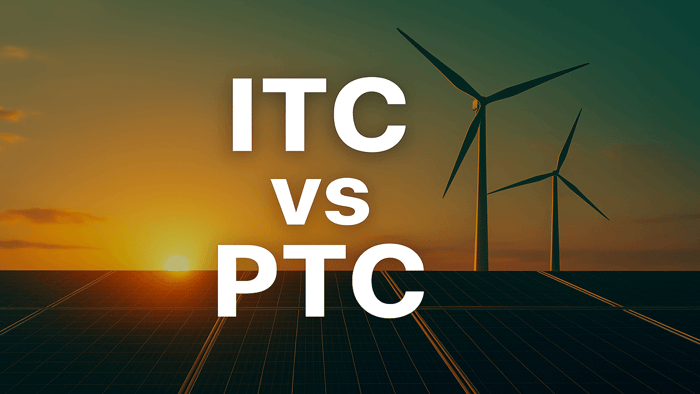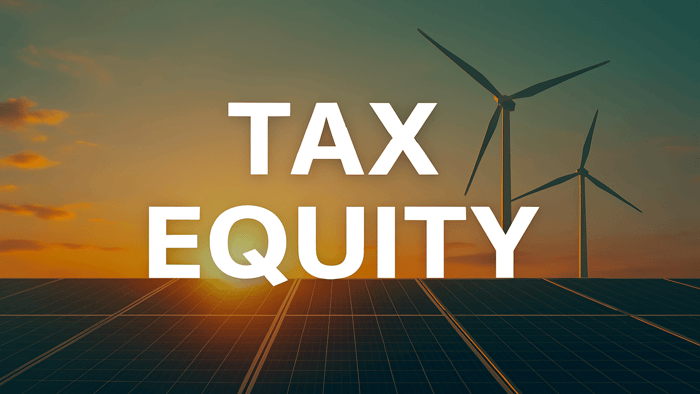Renewable energy projects depend on federal tax incentives to drive down capital costs and improve project returns. The debate of ITC vs PTC is a crucial one for developers and finance professionals alike. With the Inflation Reduction Act (IRA) reshaping federal incentives, determining which credit best suits your project can have a significant impact on cash flow, financing structure, and overall project economics. This article provides a detailed examination of ITC vs PTC, covering eligibility, project fit, timing, tax equity strategy implications, modeling insights, and the effect of IRA enhancements and adders.
1. Introduction
In today’s renewable energy landscape, the decision between the Investment Tax Credit (ITC) and the Production Tax Credit (PTC) is more critical than ever. The choice between ITC vs PTC affects everything from immediate cash flow benefits to long-term revenue streams. With the IRA introducing transformative changes such as transferability, direct pay, and bonus credits, the decision-making process has become even more nuanced. Whether you are working on solar, wind, or hybrid projects, understanding the differences between ITC vs PTC is essential for structuring deals that maximize value and attract tax equity investors.
2. Understanding the Credits
What Is the ITC?
The Investment Tax Credit (ITC) provides an immediate tax reduction calculated as a percentage of the eligible capital cost. This upfront benefit is particularly attractive for projects with significant initial expenditures, such as large-scale solar installations. Enhancements under the IRA—like transferability and direct pay—have increased the ITC’s flexibility, enabling project sponsors to monetize these credits even if they cannot fully utilize them on their own.
What Is the PTC?
The Production Tax Credit (PTC), on the other hand, offers a per-kilowatt-hour credit over a predetermined period based on actual energy production. This structure benefits projects where performance and sustained output are critical, particularly wind energy. The PTC rewards consistent production with high capacity factors over time, providing a long-term income stream that can be integrated into financial models.
When comparing ITC vs PTC, the core difference lies in timing: the ITC offers an immediate boost to tax liability reduction, while the PTC accrues benefits over several years based on energy output.
3. Eligibility and Project Fit
Eligibility Criteria
The eligibility requirements for the ITC and the PTC differ significantly:
ITC Eligibility:
Primarily available for solar and certain other renewable projects.
Calculated as a percentage of capital investment.
Must be claimed in the year the project is placed in service.
PTC Eligibility:
Most commonly used in wind projects, though it may apply to other technologies.
Tied to measurable energy production over a set period.
Requires robust operational performance to capture full benefits.
Project Type and Technology Fit
The decision of ITC vs PTC also depends on the nature of the technology:
Solar Projects:
Often favor the ITC because they are capital-intensive and benefit from the immediate credit.Wind Projects:
Typically align with the PTC due to the importance of ongoing energy production at a higher capacity factor in driving revenue.
Careful evaluation of your project’s technology, capital cost profile, and production potential is key when assessing ITC vs PTC.
4. Timing Considerations and Cash Flow Implications
Timing of the Credits
ITC Timing:
The ITC is claimed in the first year of service, providing an upfront cash flow benefit that can improve early project economics.
PTC Timing:
The PTC is distributed over several years, aligning with the project’s operational phase and incentivizing sustained performance.
Cash Flow and Financial Structuring
The timing differences in ITC vs PTC have important implications for cash flow modeling and debt structuring. An ITC structure can lead to improved early cash flow, which may reduce financing costs and enhance debt service coverage. In contrast, a PTC structure requires detailed forecasting of energy production, meaning that long-term operational performance is integral to its value.
Understanding these timing nuances helps finance professionals accurately model project returns and optimize capital structures.
5. Tax Equity Strategy Implications
Tax equity plays a pivotal role in renewable energy project finance, and the choice between ITC vs PTC influences deal structure significantly.
Integrating Tax Equity
ITC Structures:
With the ITC’s front-loaded benefit, tax equity investors often receive a higher proportion of early tax benefits. This is commonly seen in partnership flip structures, where the investor’s share of cash flows is high until a target yield is achieved.PTC Structures:
Because the PTC is earned over time, the tax equity structure must account for a longer investment horizon. This can affect the timing of cash flow waterfalls and yield flips, impacting overall investor returns.
A well-structured tax equity deal can leverage the benefits of either credit, so evaluating ITC vs PTC is essential for designing optimal financing strategies.
6. Modeling Insights for ITC vs PTC
Accurate financial modeling is crucial when evaluating ITC vs PTC. Incorporating realistic assumptions, inflation adjustments, and numerical benchmarks from recent IRS guidance helps ensure that the chosen credit aligns with your project’s financial goals.
Modeling the ITC
The ITC is typically modeled as an immediate reduction in the capital expenditure requirement. For example, if a solar project has a capital cost of $10 million and qualifies for a 30% ITC, the project’s effective CapEx is reduced by $3 million in the year it is placed in service. This upfront reduction directly lowers the initial investment burden, thereby improving the project’s overall economics by reducing the amount of debt required to finance the project. Although this benefit does not directly impact metrics like the debt service coverage ratio (DSCR), it does reduce the effective project cost and enhances early cash flow from a financing perspective.
Modeling the PTC
The PTC is a performance-based credit that is tied to actual energy production over a multi-year period—typically 10 to 15 years. According to IRS guidance released on July 11, 2024, for facilities placed in service before January 1, 2022, the credit for renewable electricity production for calendar year 2024 is:
2.9 cents per kilowatt-hour (kWh) for electricity produced from wind, closed-loop biomass, and geothermal energy.
1.5 cents per kWh for electricity produced from open-loop biomass, landfill gas, trash, qualified hydropower, and marine and hydrokinetic renewable energy.
For facilities placed in service after December 31, 2021, the credit amounts are lower:
0.6 cents per kWh for wind, closed-loop biomass, geothermal, and solar energy.
0.3 cents per kWh for open-loop biomass, landfill gas, trash, qualified hydropower, and marine and hydrokinetic renewable energy.
These amounts can increase significantly if prevailing wage and apprenticeship requirements are met—rising to 3 cents per kWh for the higher credit and 1.5 cents per kWh for the lower credit category. Additionally, for qualified hydropower and marine/hydrokinetic facilities placed in service after December 31, 2022, the PTC is 0.6 cents per kWh or 3 cents per kWh if the wage requirements are satisfied.
Because the PTC benefits are spread out over the project’s operational life, it is essential to build detailed production forecasts into your financial model. Conservative yet realistic energy production assumptions are key, as the credit’s value is highly sensitive to actual output. Inflation adjustments—like those noted in the IRS guidance—ensure that the PTC remains competitive over time, even as credit rates evolve.
Integrating the Assumptions
When comparing ITC vs PTC in your model, consider these points:
For the ITC, reduce the initial capital expenditure by the applicable percentage (e.g., a 30% reduction on a $10 million project results in a $3 million benefit).
For the PTC, project the annual energy production (in kWh) and multiply it by the applicable credit rate, factoring in any inflation adjustments and bonus credits such as domestic content or energy community adders if your project qualifies.
Compare the net present value (NPV) of the upfront ITC benefit with the cumulative, performance-based PTC credits over the credit period to determine which structure delivers better overall financial returns for your specific project profile.
By incorporating these numerical benchmarks and assumptions into your financial model, you can more effectively evaluate ITC vs PTC. This detailed approach allows you to understand the trade-offs between immediate capex reduction and long-term production-based incentives, ensuring that your chosen tax credit strategy is well-suited to the project's operational and financial characteristics.
7. IRA Enhancements and Additional Provisions
The Inflation Reduction Act (IRA) has significantly reshaped the ITC vs PTC landscape by introducing key enhancements and bonus provisions that can substantially boost the overall value of both credits.
Transferability and Direct Pay
Transferability:
The IRA now permits the transfer of tax credits to unrelated parties. This means that if a project sponsor cannot fully utilize the credit, it can be sold to monetize the benefit. For instance, a solar project with a base ITC of 30% can still capture the full value of its credit by transferring any excess to an investor, thereby enhancing liquidity without waiting to fully absorb the credit through its tax liability.Direct Pay:
Certain qualifying projects can opt for direct cash payments in lieu of receiving tax credits. By converting the tax credit into immediate cash, direct pay simplifies the financing process and provides instant liquidity, which can be especially beneficial for smaller developers or those with limited tax appetite.
Bonus Credits and Adder Provisions
The IRA also provides bonus credits and adders that further enhance the value of both the ITC and the PTC:
Domestic Content Adder:
Projects that meet specific domestic content requirements—such as using U.S.-made components—can receive additional bonus credits. For example, solar projects that adhere to these standards may see their ITC rate increase from a base of 30% up to as much as 40%, effectively reducing the project's net capital cost by an extra 10 percentage points.Energy Community Adder:
Bonus credits are available for projects located in designated energy communities, which are areas adversely affected by the decline of fossil fuel industries. These adder provisions can further improve project economics by enhancing the credit value and supporting local economic development. While specific percentage increases vary, projects in these areas benefit from a competitive boost in the overall credit calculation.Other Adder Provisions:
Additional incentives may apply for projects that meet prevailing wage, apprenticeship, or other regulatory standards. According to IRS guidance released on July 11, 2024, for facilities placed in service after December 31, 2021, the base Production Tax Credit (PTC) is 0.6 cents per kWh (or 0.3 cents per kWh for certain resource categories). However, if prevailing wage and apprenticeship requirements are satisfied, these amounts can increase dramatically—to 3 cents per kWh or 1.5 cents per kWh, respectively. Such substantial bonus credits can significantly enhance the long-term value of the PTC.
Overall Impact
These IRA enhancements are vital considerations in the ITC vs PTC decision-making process. They directly affect the effective credit value by either reducing the upfront capital cost (in the case of the ITC) or by increasing the annual production-based benefits (for the PTC). In turn, this improves the overall attractiveness of federal incentives, making them more competitive and better aligned with project-specific needs.
Incorporating these enhancements into financial models and strategic planning ensures that developers and finance professionals can fully capitalize on available incentives, optimizing both tax equity structures and project returns.
8. Key Considerations for Decision-Making
When deciding on ITC vs PTC, several factors must be weighed:
Capital Intensity:
Projects with high upfront costs often benefit more from the ITC due to its immediate cash flow advantage.Production Profile:
For projects where ongoing energy output at high capacity factors drives revenue—such as wind farms—the PTC’s long-term benefits may be more appropriate.Financial Modeling:
Consider how each credit integrates into your financial models and impacts key metrics like debt service coverage and internal rate of return.IRA Provisions:
Evaluate whether your project qualifies for bonus credits or adders, such as domestic content or energy community benefits, as these can tip the balance in favor of one credit over the other.Tax Equity Considerations:
The choice between ITC vs PTC also influences tax equity structuring. Linking to our detailed discussion on tax equity can provide additional insights into how these credits are financed in practice.
A comprehensive assessment of these factors will guide you toward the most beneficial choice for your project.
9. Conclusion
Deciding between ITC vs PTC is a multifaceted process that requires a deep understanding of federal incentives, project characteristics, and financial modeling techniques. By analyzing eligibility, timing, cash flow implications, and the impact of IRA enhancements—including transferability, direct pay, and bonus adders—developers and finance professionals can make informed decisions that optimize project returns.
The comparison of ITC vs PTC is not merely a tax planning exercise; it is central to structuring deals that attract tax equity, improve financing terms, and ensure long-term project viability. For those interested in exploring the intricacies of renewable energy finance further, our previous article on tax equity offers additional insights into structuring these complex deals.
This in-depth guide to ITC vs PTC aims to equip you with the knowledge needed to make the right decision for your renewable energy project. By carefully weighing the benefits and drawbacks of each credit and considering the latest enhancements under the IRA, you can create robust financial structures that deliver lasting value.
For more expert insights into renewable energy project finance and to enhance your analytical skills, explore our advanced resources and training programs. Whether you are new to the field or looking to deepen your expertise, staying current with developments in federal incentives and tax equity strategies is key to driving success in today’s competitive market.
Become a Certified Expert in Renewable Energy Finance
Take the next step with the Renewables Valuation Analyst (RVA) Certification Program — a comprehensive, hands-on training program for professionals working in renewable energy project finance.
What’s included:
Over 35 hours of expert-led, on-demand video content
Real-world case studies covering solar, wind, and hydro projects
Advanced Excel-based financial modeling techniques
In-depth coverage of valuation approaches, debt structuring, and IRR optimization
Lifetime access with all future updates included
Who it’s for:
Renewable energy developers and financial analysts
Project finance professionals seeking to sharpen their modeling skills
Anyone aiming to build a career in clean energy finance
Earn your RVA Certification:
Upon completion, you’ll receive a professional certificate that demonstrates your expertise in renewable energy valuation and financial modeling.







